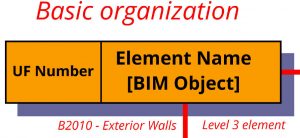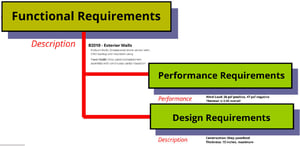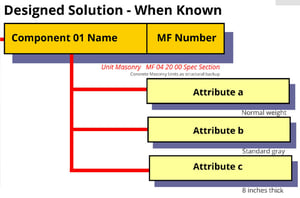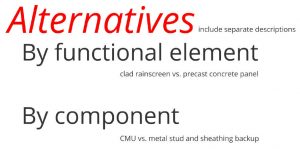Preliminary Project Descriptions (PPD) are a formal method of presenting construction project data in a consistent, organized fashion. PPDs are arranged by element name, functional requirements, and system components - using the same organization as preliminary project estimates.
Imagine the possibilities when given a tool designed for comparing elements and costs fairly and accurately to make informed design decisions.
 Element Name
Element Name
The elements are organized by UniFormat number and the name that UniFormat assigns to each number. Like MasterFormat® it is best to use the assigned numbers and titles so PPDs remain consistent across all projects.
Functional Requirements
Identify the element requirements - by description, by performance, and by design requirements.
Description
Include the information that is known about each project element. This may be a simple description of one or more types of each element. Be sure to describe the entire assembly by painting a mental image of what is required. When constructing the statements try to follow the form of What, How, and Where. State what will be installed, how it will be installed and where it will be installed. These descriptions can be used to identify or supplement project scope shown on the drawings.
If the element applies to a specific location within the project, then say so, especially when the drawings do not. Remember, this is about conveying enough information so owners and lenders understand and so estimates are meaningful.
Performance and Design Requirements
Identify both the performance and design requirements. Performance will include all those measurable criteria that will eventually be transferred to the construction specifications to control the project quality.
Describe the design requirements that will constrain the final designed solution. These may be dimensional, aesthetic, construction, and other constraints, that are not shown on the drawings, but will be shown or specified, eventually. Be sure to identify considerations with substantial cost or quality impact - full scale mockups, custom fabrications, custom colors, and multiple colors, textures and patterns, for example.
Designed Solution
Identify individual components that will be required for the designed solution, but only when the solution is known.
A link to the future construction specifications can be built as the designed solution components are identified. MasterFormat® can be used as a checklist to help list specific components.
Our most recent project used MasterFormat® numbers and specification titles to list each known component at the Schematic Design (SD) Phase. Essentially an outline spec for components was included in the document. This allowed coordination with our client's office standard and with the owner's recently updated design standards. Ensuring this coordination is complete at SD will improve the coordination when the construction specifications are started.
Be sure to include the function for the components to explain the design intent and to help guide the future specifications development. This will be a quick reminder to assess what conditions changed during Design Development Phase.
Attributes
Use attributes to further define each component. But remember only to include what is known at each stage of the document development. New or additional information can be inserted anytime, as the design develops.
Alternatives
One of the most powerful aspects of PPDs is the ability to describe alternatives in a way that allows easy comparison of one complete assembly to another - description, performance, and cost.
Alternates can be completely different assemblies or different components within the same assembly. For instance, the PPD may include a clad rainscreen wall system as one option to be compared with a precast wall panel system. It is important to describe each complete system to ensure a fair comparison. This means everything - the backup, sheathing, air barrier, insulation, attachments - everything except the interior finish applied to the exterior wall.
Another form of alternative can be the substitution of an individual component within a system for another component used in the same system. For instance a stone veneer may be considered in place of a clay brick veneer.
Regardless the alternative type, by aligning the assembly description with the estimate, a true comparison of proposed assemblies can be made by taking into account the differences between complete systems. Ultimately the PPD becomes the record by documenting the alternatives and the decisions to accept or reject each one.



